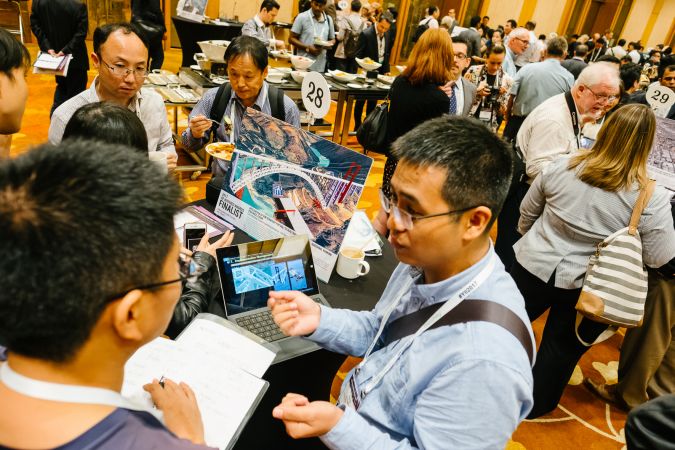The Geospatial Contribution to Digital Twins
A Surveyor’s Perspective on Bentley’s Year in Infrastructure Conference 2017
The digitalisation of our world is in full swing. It is transforming the way we live, work, communicate, entertain and are being governed. Construction and infrastructure are also entering the digital era, although there is still a lot of work to do – the sector is lagging behind compared to some others. Bentley Systems plays an important role in the transition to a digital representation of the built environment. The company’s annual Year in Infrastructure Conference, held in Singapore in November of this year, showed that the digital era presents many chances for the geospatial industry. Digitalisation products are often referred to as ‘digital twins’ and, since BIM stores huge amounts of geospatial information, it is the ‘digital DNA’ of construction projects.
As Greg Bentley, CEO of Bentley Systems, mentioned at the 2017 event’s press conference, the construction industry is conservative. Bearing in mind that 80% of construction and infrastructure projects are either too expensive or finished too late, the sector had better become aware of the benefits of digitalisation – and fast. A huge improvement in efficiency is on the horizon. However, it would be unfair to only blame the construction world for being too slow. Many solutions that will boost digitalisation come from the geospatial field, so companies in this area should be on the front row and have their seatbelts already fastened. The Year in Infrastructure Conference 2017 visualised where the digital road is heading and how geomatics could contribute.
Digital representation
The role for the geospatial sector can be summarised as supporting firms in their ‘going digital’ strategy. Bentley is obviously doing this, as advancing the construction and infrastructure industry is its core business. However, the solutions delivered by Bentley won’t work without the input provided by surveying and mapping professionals. If innovative software is the engine of digitalisation, geospatial data is its fuel. Digitalisation products are often referred to as ‘digital twins’: 3D reality models that form a digital representation of the built environment, such as construction sites, infrastructure developments, mines, oil & gas fields, power plants, airports and so on. In the same analogy, BIM stores huge amounts of geospatial information, making it the ‘digital DNA’ of construction projects.

Regular and accurate site surveys are crucial in achieving a well-functioning BIM, and the Year in Infrastructure Conference in Singapore provided an overview of numerous projects with a wide variety of geospatial involvement. A project carried out by Jacobs/Zephyr UAS consisted of mapping approximately 70km of a high-speed rail corridor in California and involved a photogrammetric drone survey; the point clouds derived from it were transformed into a digital terrain model. This project is an example of how Bentley products can be advantageously combined with innovative unmanned aerial vehicle (UAV) technology. The UAV made the acquired data available immediately in the desired resolution (ranging from 5cm to 15cm per pixel). Mapping the rail corridor with a satellite or a manned aircraft would have taken weeks if not months, while terrestrial mapping would have been slow and dependent on the availability of a professional. Carried out with ProjectWise, Microstation and Power RailTrack, the project cost only USD70,000, whereas conventional mapping methods would have cost closer to USD550,000. In other words, UAV mapping achieved a cost reduction of 86%.
Map for self-driving cars
Another intriguing project consisted of feature extraction technology developed by Sanborn. This technology enables the extraction of transportation objects in a semi-automated manner. Both airborne and mobile Lidar data was captured over the project area with existing control and datasets. The highly accurate data was processed with ContextCapture Center, allowing the quick production of 3D mesh models of the urban environment from Sanborn’s high-precision oblique imagery. The 3D mesh forms the basis of the Sanborn HD Maps urban datasets for self-driving cars. The combination of aerial Lidar and photogrammetry was labelled as ‘Lidargrammetry’, and resulted in enormous amounts of point-cloud data which was merged together using TerraScan in Bentley MicroStation. One advantage of merging point clouds collected from different sensor platforms is that it can fill the gaps for each individual technology. Another major benefit is the ability to extract stationary physical objects related to roadways, such as shoulders, traffic signals, paint markings and poles, which leads to a scalable approach for maintaining highly detailed inventories.

Real-time digital twin
A third project that – along with many others – definitely deserves a mention is the development of the Anderson Road Quarry site in Hong Kong, a facility that used to supply the region with aggregate, asphalt, stone and concrete. The vacated quarry is now being transformed into a residential and commercial area, and will accommodate 25,000 citizens. From 2023 onwards, the former quarry will be an urban area that meets all the requirements of the smart city concept. Whereas a traditional survey would have taken more than a month, the quarry was mapped in just one day using a UAV and photogrammetry technology. The reality modelling was carried out with ContextCapture, while the visual animations were done with LumenRT. The result is a real-time, continuously updated digital twin that can be accessed anytime and anywhere, making the reality model available for various stakeholders such as clients, citizens, consultants and contractors. The 3D cadastral boundaries are an interesting geospatial component of the project, which won a Be Inspired Award.
An integrated environment using reality modelling has many advantages; it reduces risks to labourers working on-site, it minimises the time and resources required for planning and monitoring construction progress, and it leads to streamlined workflows which avoid costly reworks.
Infrastructure-geospatial Partnerships
The event was also the ideal occasion to announce significant initiatives that are bringing the geospatial and the building industries closer together. The Bentley-Topcon partnership is a major alliance that will add weight to the integration of geomatics and the construction and infrastructure industry. Topcon and Bentley will collaborate to create the Constructioneering Academy curriculum which will be implemented through existing learning centres located in Livermore, California (Topcon), Houston, Texas, and London, UK (Bentley). These learning centres are aimed at enabling construction industry professionals to learn best practices in constructioneering. The Bentley-Topcon collaboration is set to speed up the digital journey, as is the cooperation between Bentley and Microsoft, with the software giant providing the architecture, engineering & construction (AEC) sector with a vital big data solution.

In 2016, Bentley and Siemens announced a strategic alliance, the goal of which is to jointly develop solutions to accelerate digitalisation of planning, design and operations for power utilities and industrial power customers. The alliance is focusing on shared contributions towards digital workflows and digital cities. At the Year in Infrastructure Conference 2017, the audience was provided with an update on the various joint development projects underway – projects that are built on the continued collaborative work done between Siemens and Bentley, converging Bentley’s BIM and reality modelling software with Siemens’ product design and production process engineering solutions.
GeoSLAM is the new kid on the block among Bentley’s partners. At the conference, it was announced that the British 3D geospatial solution provider and Bentley are joining forces to take mobile reality modelling indoors. The aim is to enable the simple and fast production of hybrid reality models in any environment. It will be interesting to keep an eye on this collaboration to see what is possible with both ContextCapture and ZEB-REVO.
Conclusion
In a construction or infrastructure project, a digital twin is very beneficial in terms of saving time and money. Abnormalities, damages and changes will be detected sooner, which means that action can be taken at an earlier stage. This makes it essential for the AEC sector to embrace digitalisation, and that’s good news for the mapping and surveying profession. It is clear that BIM and reality modelling open up intriguing opportunities for surveyors. Geospatial information is so strongly connected to BIM that it must feel very familiar and convenient to geospatial professionals. Bearing in mind the recent debate about the future of the surveyor, perhaps we should wonder whether the nature of that discussion hasn’t been too negative so far.
For a closer look at the new solutions provided and presented by Bentley Systems, see here: www.bentley.com/news.
BIM
BIM may have been a buzzword for the past couple of years, but some geomatics professionals still seem unsure about what exactly it encompasses. In short, building information modelling (BIM) is a process in which an intelligent 3D model is created and used to make decisions for projects and to communicate them. It is a digital representation of physical and functional characteristics of places. Building information models are being used for planning, design and construction purposes, and for maintaining assets and infrastructure. BIM is increasingly being used by construction firms, but there is still much to improve.

Value staying current with geomatics?
Stay on the map with our expertly curated newsletters.
We provide educational insights, industry updates, and inspiring stories to help you learn, grow, and reach your full potential in your field. Don't miss out - subscribe today and ensure you're always informed, educated, and inspired.
Choose your newsletter(s)
























